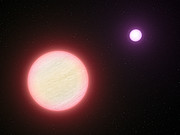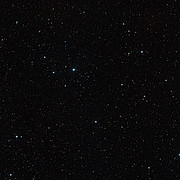Comunicato Stampa
Una coppia di nane brune alquanto fredde
23 Marzo 2011
Osservazioni con il VLT (Very Large Telescope) dell’ESO e con altri due telescopi hanno scovato un nuovo candidato per la stella più fredda che si conosca: una nana bruna in un sistema binario che ha la stessa temperatura di una tazza di tè – bollente in termini umani, ma straordinariamente fredda per essere la superficie di una stella. Questo oggetto è sufficientemente freddo da scavalcare la linea incerta che divide le piccole stelle fredde dai grandi pianeti caldi.
Le nane brune sono sostanzialmente stelle mancate: non hanno massa sufficiente perchè la loro gravità inneschi le reazioni nucleari che fanno risplendere le stelle. Questa nana bruna appena scoperta, chiamata CFBDSIR 1458+10B, è la più debole di una coppia di nane brune situate a soli 75 anni luce dalla Terra [1].
X-shooter, il potente spettrografo installato sul VLT (Very Large Telescope) dell’ESO ha permesso di mostrare che l’oggetto composito era molto freddo anche per essere una nana bruna. “Eravamo molto emozionati nel vedere che quest’oggetto aveva una temperatura così bassa, ma non potevamo certo prevedere che si sarebbe dimostrato essere un sistema binario con una seconda componente ancora più interessante, ancora più fredda,” dice Philippe Delorme dell’Istituto di planetologia e d’astrofisica di Grenoble (CNRS/Università Joseph Fourier), uno dei co-autori dell’articolo. CFBDSIR 1458+10 è il sistema binario di nane brune più freddo ad oggi conosciuto.
La più debole delle due nane ha una temperatura di circa 100 gradi centigradi – la temperatura di ebollizione dell’acqua, non molto più alta della temperatura di una sauna [2]. “A queste temperature ci attendiamo proprietà diverse da quelle delle nane brune già note e molto più simili a quelle dei pianeti giganti extra-solari – la nana potrebbe avere addirittura nubi di vapor acqueo nell’atmosfera,” dice Michael Liu dell’Institute for Astronomy dell’Università delle Hawaii, l’autore principale dell’articolo che descrive questa nuova scoperta. “Infatti quando, in un futuro molto prossimo, inizieremo a fotografare i pianeti giganti gassosi che orbitano intorno a stelle simili al Sole, mi aspetto che molti di essi siano simili a CFBDSIR 1458+10B”.
Per scoprire i segreti di questo oggetto finora unico è stato necessario sfruttare la potenza di tre diversi telescopi. CFBDSIR 1458+10 è stata identificata come un sistema binario utilizzando le Ottiche Adattive LSG (Laser Guide Star) del telescopio Keck II alle Hawaii [3]. Liu e i suoi colleghi hanno quindi utilizzato il telescopio Canada-France-Hawaii (CFHT), anch’esso alle Hawaii, per determinare la distanza del sistema di nane brune, utilizzando un rivelatore per raggi infrarossi [4]. Infine, il VLT dell’ESO è stato usato per studiare lo spettro infrarosso dell’oggetto e misurarne la temperatura.
La caccia di oggetti freddi è un campo molto attivo nell’astronomia moderna. Recentemente il telescopio spaziale Spitzer ha identificato altri due oggetti molto deboli che si candidano ad avere la temperatura più bassa per una nana bruna, anche se le misure di questi ultimi non sono ancora sufficientemente precise. Future osservazioni potranno dire se questi oggetti sono freddi come o di più di CFBDSIR 1458+10B. Liu e colleghi invece vogliono osservare di nuovo la nana bruna per determinarne le proprietà in dettaglio e per iniziare a costruire una mappa dell’orbita della binaria che, dopo una decina di anni di osservazioni regolari, dovrebbe permettere anche una misura della massa del sistema binario.
Note
[1] CFBDSIR 1458+10 è il nome del sistema binario. Le due componenti sono CFBDSIR 1458+10A e CFBDSIR 1458+10B, il secondo è il più debole e freddo dei due. L’orbita appare di dimensione circa tre volte la distanza tra la Terra e il Sole, e il periodo sembra essere di cerca trent’anni.
[2] Per confronto, la temperatura della superficie del Sole è di circa 5550 gradi centigradi.
[3] L’ottica adattiva rimuove la maggior parte dell’interferenza dovuta all’atmosfera terrestre, migliorando di circa dieci volte la nitidezza dell’immagine e permettendo per esempio di risolvere la distanza, molto piccola, tra le due componenti del sistema binario.
[4] Gli astronomi hanno misurato il moto apparente delle nane brune, rispetto allo sfondo delle stelle più lontane, causato dallo spostamento della Terra nella sua orbita intorno al Sole. Questo effetto, noto come parallasse, ha permesso di determinare la distanza delle nane brune da noi.
Ulteriori Informazioni
Questo lavoro è stato presentato nell'articolo “CFBDSIR J1458+1013B: A Very Cold (>T10) Brown Dwarf in a Binary System”, Liu et al. che verrà pubblicato nella rivista Astrophysical Journal.
L'equipe di lavoro è formata da Michael C. Liu (Institute for Astronomy [IfA], University of Hawaii, USA), Philippe Delorme (Institut de planétologie et d’astrophysique de Grenoble, CNRS/Université Joseph Fourier, France [IPAG]), Trent J. Dupuy (Harvard-Smithsonian Center for Astrophysics, Cambridge, USA), Brendan P. Bowler (IfA), Loic Albert (Canada-France-Hawaii Telescope Corporation, Hawaii, USA), Etienne Artigau (Université de Montréal, Canada), Celine Reylé (Observatoire de Besançon, France), Thierry Forveille (IPAG) e Xavier Delfosse (IPAG).
L’ESO (European Southern Observatory) è la principale organizzazione intergovernativa di Astronomia in Europa e l’osservatorio astronomico più produttivo al mondo. È sostenuto da 15 paesi: Austria, Belgio, Brasile, Danimarca, Finlandia, Francia, Germania, Gran Bretagna, Italia, Olanda, Portogallo, Repubblica Ceca, Spagna, Svezia, e Svizzera. L’ESO svolge un ambizioso programma che si concentra sulla progettazione, costruzione e gestione di potenti strumenti astronomici da terra che consentano agli astronomi di realizzare importanti scoperte scientifiche. L’ESO ha anche un ruolo di punta nel promuovere e organizzare la cooperazione nella ricerca astronomica. L’ESO gestisce tre siti osservativi unici al mondo in Cile: La Silla, Paranal e Chajnantor. Sul Paranal, l’ESO gestisce il Very Large Telescope, osservatorio astronomico d’avanguardia nella banda visibile. L’ESO è il partner europeo di un telescopio astronomico di concetto rivoluzionario, ALMA, il più grande progetto astronomico esistente. L’ESO al momento sta progettando l’European Extremely Large Telescope o E-ELT (significa Telescopio Europeo Estremamente Grande), di 42 metri, che opera nell'ottico e infrarosso vicino e che diventerà “il più grande occhio del mondo rivolto al cielo”.
Links
Contatti
Michael Liu
Institute for Astronomy, University of Hawaii
USA
Tel.: +1 808 956 6666
E-mail: mliu@ifa.hawaii.edu
Philippe Delorme
Institut de planétologie et d’astrophysique de Grenoble
France
Tel.: +33 4 76 63 58 30
E-mail: Philippe.Delorme@obs.ujf-grenoble.fr
Christian Veillet
Executive Director, CFHT, Hawaii
USA
Tel.: +1 808 885 7944
E-mail: veillet@cfht.hawaii.edu
Richard Hook
ESO, La Silla, Paranal, E-ELT and Survey Telescopes Press Officer
Garching bei München, Germany
Tel.: +49 89 3200 6655
E-mail: rhook@eso.org
Joerg Gasser (press contact Svizzera)
Rete di divulgazione scientifica dell'ESO
E-mail: eson-switzerland@eso.org
Sul Comunicato Stampa
| Comunicato Stampa N": | eso1110it-ch |
| Nome: | CFBDSIR 1458+10 |
| Tipo: | Milky Way : Star : Type : Brown Dwarf |
| Facility: | CFHT, New Technology Telescope, Very Large Telescope, W. M. Keck Observatory |
| Instruments: | SOFI, X-shooter |
| Science data: | 2011ApJ...740..108L |
Our use of Cookies
We use cookies that are essential for accessing our websites and using our services. We also use cookies to analyse, measure and improve our websites’ performance, to enable content sharing via social media and to display media content hosted on third-party platforms.
ESO Cookies Policy
The European Organisation for Astronomical Research in the Southern Hemisphere (ESO) is the pre-eminent intergovernmental science and technology organisation in astronomy. It carries out an ambitious programme focused on the design, construction and operation of powerful ground-based observing facilities for astronomy.
This Cookies Policy is intended to provide clarity by outlining the cookies used on the ESO public websites, their functions, the options you have for controlling them, and the ways you can contact us for additional details.
What are cookies?
Cookies are small pieces of data stored on your device by websites you visit. They serve various purposes, such as remembering login credentials and preferences and enhance your browsing experience.
Categories of cookies we use
Essential cookies (always active): These cookies are strictly necessary for the proper functioning of our website. Without these cookies, the website cannot operate correctly, and certain services, such as logging in or accessing secure areas, may not be available; because they are essential for the website’s operation, they cannot be disabled.
Functional Cookies: These cookies enhance your browsing experience by enabling additional features and personalization, such as remembering your preferences and settings. While not strictly necessary for the website to function, they improve usability and convenience; these cookies are only placed if you provide your consent.
Analytics cookies: These cookies collect information about how visitors interact with our website, such as which pages are visited most often and how users navigate the site. This data helps us improve website performance, optimize content, and enhance the user experience; these cookies are only placed if you provide your consent. We use the following analytics cookies.
Matomo Cookies:
This website uses Matomo (formerly Piwik), an open source software which enables the statistical analysis of website visits. Matomo uses cookies (text files) which are saved on your computer and which allow us to analyze how you use our website. The website user information generated by the cookies will only be saved on the servers of our IT Department. We use this information to analyze www.eso.org visits and to prepare reports on website activities. These data will not be disclosed to third parties.
On behalf of ESO, Matomo will use this information for the purpose of evaluating your use of the website, compiling reports on website activity and providing other services relating to website activity and internet usage.
Matomo cookies settings:
Additional Third-party cookies on ESO websites: some of our pages display content from external providers, e.g. YouTube.
Such third-party services are outside of ESO control and may, at any time, change their terms of service, use of cookies, etc.
YouTube: Some videos on the ESO website are embedded from ESO’s official YouTube channel. We have enabled YouTube’s privacy-enhanced mode, meaning that no cookies are set unless the user actively clicks on the video to play it. Additionally, in this mode, YouTube does not store any personally identifiable cookie data for embedded video playbacks. For more details, please refer to YouTube’s embedding videos information page.
Cookies can also be classified based on the following elements.
Regarding the domain, there are:
- First-party cookies, set by the website you are currently visiting. They are stored by the same domain that you are browsing and are used to enhance your experience on that site;
- Third-party cookies, set by a domain other than the one you are currently visiting.
As for their duration, cookies can be:
- Browser-session cookies, which are deleted when the user closes the browser;
- Stored cookies, which stay on the user's device for a predetermined period of time.
How to manage cookies
Cookie settings: You can modify your cookie choices for the ESO webpages at any time by clicking on the link Cookie settings at the bottom of any page.
In your browser: If you wish to delete cookies or instruct your browser to delete or block cookies by default, please visit the help pages of your browser:
Please be aware that if you delete or decline cookies, certain functionalities of our website may be not be available and your browsing experience may be affected.
You can set most browsers to prevent any cookies being placed on your device, but you may then have to manually adjust some preferences every time you visit a site/page. And some services and functionalities may not work properly at all (e.g. profile logging-in, shop check out).
Updates to the ESO Cookies Policy
The ESO Cookies Policy may be subject to future updates, which will be made available on this page.
Additional information
For any queries related to cookies, please contact: pdprATesoDOTorg.
As ESO public webpages are managed by our Department of Communication, your questions will be dealt with the support of the said Department.




